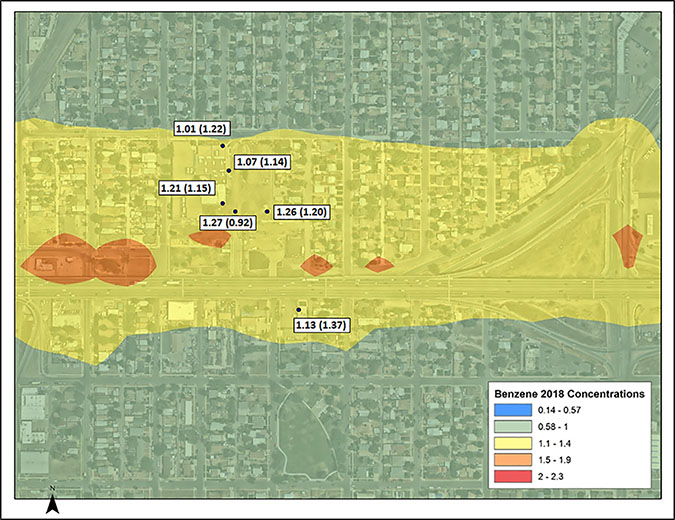Mobile Source Air Toxics in an Environmental Justice Denver Community Adjacent to a Freeway
Clients
U.S. Environmental Protection Agency
Sonoma Technology conducted three measurement campaigns to quantify the gradient in black carbon and air toxics concentrations originating from the I-70 freeway in an Environmental Justice (EJ) neighborhood in Denver, Colorado. No statistically significant gradient in air toxics was found, which is in contrast to findings of other earlier studies. The results of this study were published in <a href="https://doi.org/10.1080/10962247.2020.1734113" target="new">Journal of the Air and Waste Management Association.</a href><br>
The abstract of the article is below:<br>
Air pollutant concentrations are often higher near major roadways than in the surrounding environments owing to emissions from on-road mobile sources. In this study, we quantified the gradient in black carbon (BC) and air toxics concentrations from the I-70 freeway in the Elyria-Swansea environmental justice neighborhood in Denver, Colorado, during three measurement campaigns in 2017-2018. The average hourly upwind-downwind gradient of BC concentrations from the roadway was 500-800 ng/m<sup>3</sup>, equal to an increment of approximately 30-80% above local background levels within 180 m of the freeway. When integrated over all wind directions, the gradients were smaller, approximately 150-300 ng/m<sup>3</sup> (~11-18%) over the course of nearly four months of measurements. No statistically significant gradient in air toxics (e.g., benzene, formaldehyde, etc.) was found, likely because the uncertainties in the mean concentrations were larger than the magnitude of the gradient (<25%). This finding is in contrast to some earlier studies in which small gradients of benzene and other VOCs were found. We estimate that sample sizes of at least 100 individual measurements would have been required to estimate mean concentrations with sufficient certainty to quantify gradients on the order of ±10% uncertainty. These gradient estimates are smaller than those found in previous studies over the past two decades; more stringent emissions standards, the local fleet age distribution, and/or the steady turnover of the vehicle fleet may be reducing the overall impact of roadway emissions on near-road communities.
The abstract of the article is below:<br>
Air pollutant concentrations are often higher near major roadways than in the surrounding environments owing to emissions from on-road mobile sources. In this study, we quantified the gradient in black carbon (BC) and air toxics concentrations from the I-70 freeway in the Elyria-Swansea environmental justice neighborhood in Denver, Colorado, during three measurement campaigns in 2017-2018. The average hourly upwind-downwind gradient of BC concentrations from the roadway was 500-800 ng/m<sup>3</sup>, equal to an increment of approximately 30-80% above local background levels within 180 m of the freeway. When integrated over all wind directions, the gradients were smaller, approximately 150-300 ng/m<sup>3</sup> (~11-18%) over the course of nearly four months of measurements. No statistically significant gradient in air toxics (e.g., benzene, formaldehyde, etc.) was found, likely because the uncertainties in the mean concentrations were larger than the magnitude of the gradient (<25%). This finding is in contrast to some earlier studies in which small gradients of benzene and other VOCs were found. We estimate that sample sizes of at least 100 individual measurements would have been required to estimate mean concentrations with sufficient certainty to quantify gradients on the order of ±10% uncertainty. These gradient estimates are smaller than those found in previous studies over the past two decades; more stringent emissions standards, the local fleet age distribution, and/or the steady turnover of the vehicle fleet may be reducing the overall impact of roadway emissions on near-road communities.
Air Quality
Applied Research
Community Monitoring
Environmental Justice
Low-Cost Sensors
Measurements


Steve G. Brown

Steve
G.
Brown
Northern California Regional Director / Senior Atmospheric Scientist
sbrown@sonomatech.com
/sites/default/files/2023-07/SGBres.pdf
